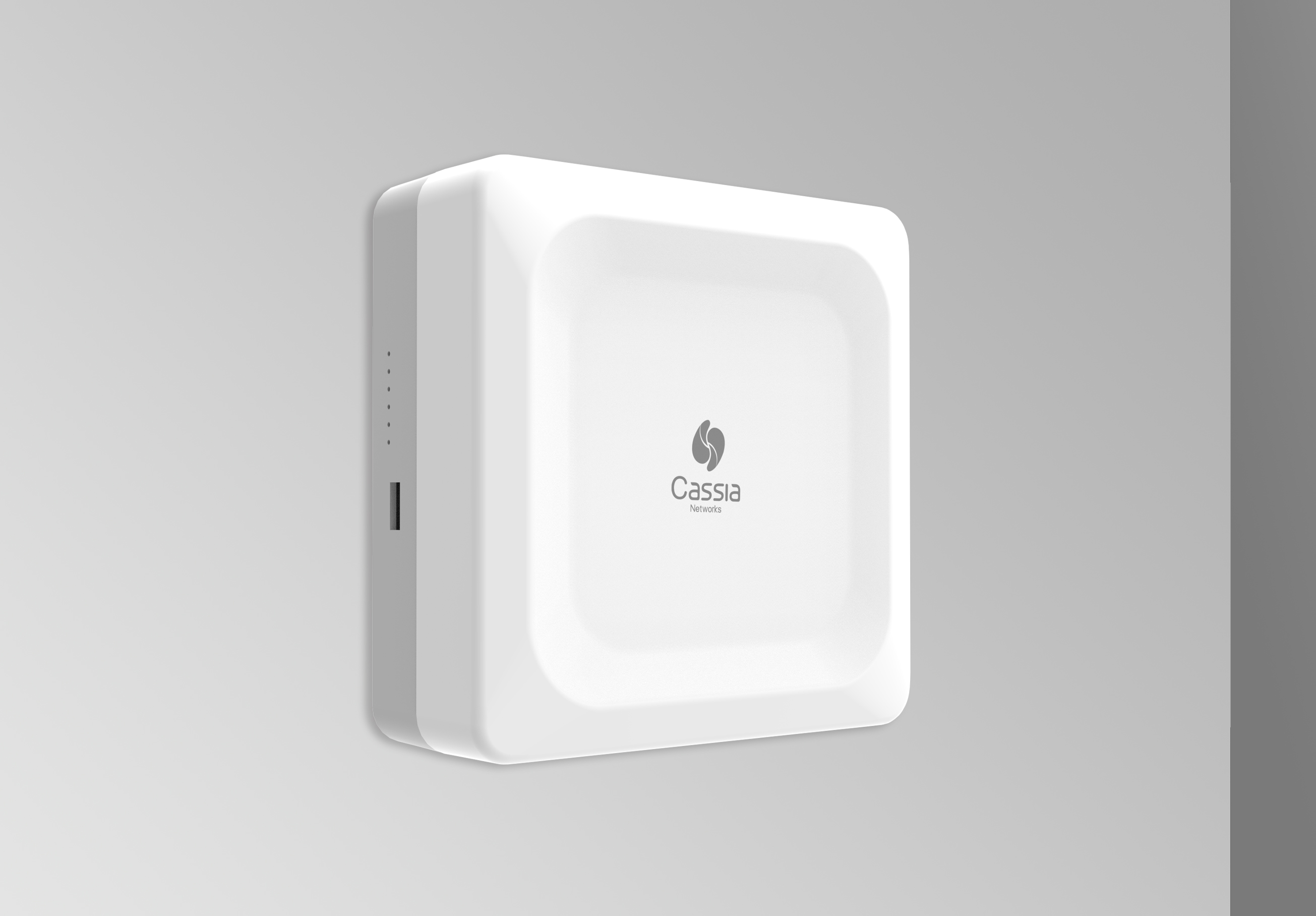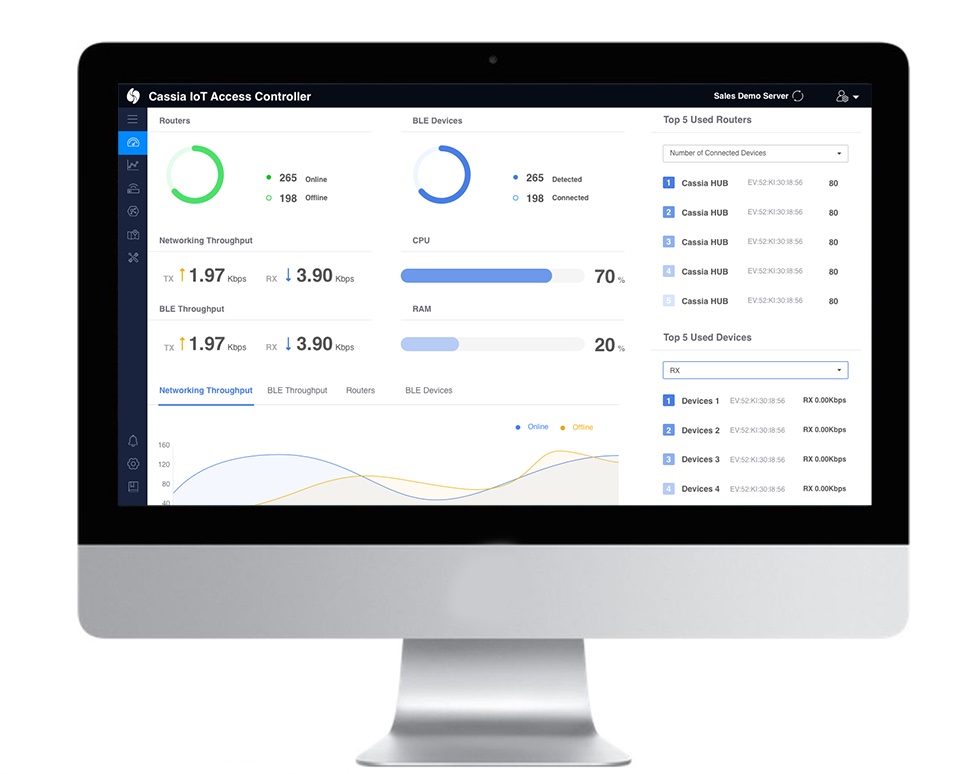Cassia Networks
Serving IoT Needs in Crowded Areas
The Opportunity
Serving IoT Needs in Crowded Areas
The emergence of the Internet of Things (IoT) has created a more connected world, and the proliferation of smart devices in recent years suggests that this trend will continue to grow in the years to come. A recent report from Business Insider predicts that there could be more than 40 billion active IoT devices by the end of 2027. This growth naturally brings new deployment challenges, especially when it comes to connecting large numbers of wireless devices simultaneously.
One factor that can complicate an IoT application is the crowding that may occur when many connected devices occupy the same area. To help corral all of these signals, many organizations opt to deploy Bluetooth gateways to help connect their deployed IoT devices to the cloud. Modern gateways can also process said data and automate responses in real-time, making them a lynchpin of a three-layer IoT architecture.
As gateways have become more integral to IoT deployments, their need to fit into crowded applications has helped evolve their design. Bluetooth gateways need to be compact enough to fit low-profile deployments, yet powerful enough to read signals from great distances. Furthermore, these Bluetooth gateways need to be efficient enough to survive long stretches in the field, yet dynamic enough to collect data from specific devices in a potentially crowded environment.
Take the case of building maintenance solution provider Zan Compute, whose monitoring service helps simplify maintenance in office buildings, business centers, and airports, among other applications. Airports in particular offer many logistical challenges due to both the number of connected devices operating within the space and the presence of multiple structural barriers that can significantly impact radio frequency (RF) penetration.

Cassia Networks“Versatile hardware and reliable connectivity are essential to any IoT deployment. By pairing Soracom’s smart connectivity solutions with Cassia’s industry-leading Bluetooth gateways, today’s enterprises are investing in the long-term growth of their operation”
The Solution
A Bluetooth Gateway that Cuts Through the Noise in Crowded Environments
To help overcome these challenges, Zan Compute has turned to Cassia Networks’ line of advanced Bluetooth gateways, chief among them the Cassia E1000. Designed specifically with indoor applications in mind, the E1000 offers long-range (up to 1000 feet), bi-directional connectivity that can simultaneously pair and connect up to 40 separate IoT devices. The E1000 gateway achieves this by translating between the Bluetooth Low Energy (BLE) protocol and IP protocol to remotely connect devices to the cloud, making them remotely accessible and controllable. This functionality allows Zan Compute to safely monitor the cleanliness and hygiene of restrooms throughout a large airport.
While the confined spaces and signal crowding implied by these applications can be challenging for some gateways, the E1000 utilizes a feature called Pure Scan™ to help keep connections strong, even in densely populated areas with low RF penetration. This feature improves device detection and scanning while working alongside powerful Bluetooth connectivity. Along with its low profile and ease of deployment, Cassia’s E1000 is an ideal solution for similarly crowded applications like hospitals and shopping centers.
Central to this functionality is the Cassia IoT Access Controller (AC), a powerful network management solution that allows users to access, control, and monitor a deployment remotely. The AC offers users a centralized interface and single-pane view supporting the management of hundreds of gateways and, by extension, thousands of devices.
Cassia’s E1000 gateways also support Bluetooth Roaming, locationing, and boast end-to-end security powered by advanced military-grade 128bit AES encryption. All of these features become even more powerful when supported by Soracom’s robust and secure connectivity technologies.
Why Soracom
Versatile Hardware Needs Versatile Connectivity
Though these gateways can be connected to the cloud via Ethernet backhaul, this won’t be an option in many settings. This makes Soracom’s wireless connectivity solutions the ideal complement to Cassia’s Bluetooth gateways. By using Soracom’s Onyx dongle to act as a cellular modem, Cassia’s gateways can take advantage of Soracom’s wide range of integrated connectivity technologies.
Soracom and Cassia are both IoT solutions created with scalability and flexibility in mind. Soracom’s User Console, for example, provides users with full control over every SIM or eSIM managed within a deployment from a single, customizable dashboard. This allows users to control their fleet – and its connectivity – down to the individual SIM, making the Soracom console a natural partner for Cassia’s IoT AC allowing for remote monitoring at scale.
This works nicely alongside Soracom Beam, a protocol converter that can help convert each gateway’s MQTT data into encrypted MQTTS to be sent to an IoT broker like AWS IoT. Offloading this encryption onto the cloud lets the gateways use less data-intensive protocols reducing both cellular data usage and power drain on each device. With Beam, users can even control their data endpoints in the cloud to simplify the management of large-scale fleets.
Zan Compute also uses Soracom Peek, a managed packet capture service, to monitor the network behavior of individual devices without setting up any servers to mirror or inspect traffic. This, in turn, works well with the Soracom Virtual Private Gateway (VPG) to provide more thoroughly secure communication between servers and devices, or even between individual devices.
Users who want to access their gateways more securely can also utilize Soracom Napter. This on-demand networking service allows devices using Soracom SIMs to securely access Cassia’s gateways remotely, simplifying remote maintenance and troubleshooting via Cassia’s web-based interface. This is all accomplished under a randomized IP address and port, securing these devices from the risks of connecting with a public IP.

The Outcome
A One-Two Punch IoT Solution
IoT deployments require a lot of moving parts, but the foundation of any successful deployment rests on strong hardware infrastructure and secure connectivity. Both organizations’ shared dedication to ensuring scalability without sacrificing security makes Cassia and Soracom natural partners in an IoT setting. The level of control afforded to applications that employ a Cassia Gateway with Soracom’s expansive suite of connectivity management makes them a powerful one-two punch for today’s enterprises looking to scale their operations. And the versatility of this solution means it can be applied in many different use cases, from industrial automation and asset tracking to smart home monitoring as well as digital health.
In the example of Zan Compute, this combination of hardware and connectivity has helped the company grow its operations securely and in a cost-efficient manner. By deploying dozens of gateways in each setting, Zan has been utilized to monitor both the cleanliness and occupancy of facilities – something that has proven invaluable since the onset of Covid-19.
And yet this is only the tip of the iceberg of what can be accomplished through a truly smart IoT ecosystem powered by Cassia and Soracom.
“Versatile hardware and reliable connectivity are essential to any IoT deployment,” says Felix Zhao, CEO of Cassia Networks. “By pairing Soracom’s smart connectivity solutions with Cassia’s industry-leading Bluetooth gateways, today’s enterprises are investing in the long-term growth of their operation.”
They say a team is only as good as the sum of its parts, and when your IoT deployment incorporates Soracom connectivity with Cassia’s powerful Bluetooth gateways, great things can happen. And because Cassia’s devices have already been certified to work with Soracom’s services, this joint solution is easily deployed and ready to work for virtually any use case.
